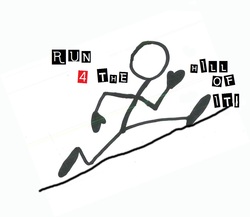
A - Hill training is a form of "resistance training", meaning that the training causes your running muscles to contract at levels that exceed what they normally would when running on the flat - the resistance to propelling the body forward is much greater than usually encountered. Weight training is another form of resistance training.
Thus the main reason for hill training ( typically running uphill for less than 60 seconds ) is to increase the power of the legs - increasing the springing forward capability. Increasing the power in turn increases the speed potential - after a hill training phase the runner can hopefully translate the increased leg power into an ability to running faster over 100 meters.
And basic running speed is the ultimate determinant of running performance at any distance.
For example, if you want to run a 4 minute mile (1,609.3 metes), you need to be capable of running about 30 seconds for every 200 meters of the 1,609.3 metres. Most of us can't run this fast - even for 200m - not because of our lungs, or heart, but simply because we lack the basic speed/leg power and/or coordination required.
But common sense will tell you that just being able to run 30 seconds for 200 meters isn't going to be good enough because one can't sprint for an entire mile. In fact, to be capable of running 4:00 minutes for the mile you should be capable of around 24 seconds for 200 meters.
As a matter of fact most of my clients are not limited in achieving there goals by basic running speed - relative areas of weakness are more typically Maximum Oxygen Intake and Specific Muscular Endurance. Hence their training programs may not require an emphasis on hill running whatsoever other than to incorporate hills during the course of their straight runs, which is particularly useful for preparing for races where the routes are hilly, e.g., Boston Marathon.
There is another valid argument for incorporating resistance training in one's program and that is increasing the power (from hills ) and strength (from weight training) will help to reduce the ever present chance of injury since any given running speed will require the muscles to contract at a reduced percentage of their maximal capability.
 RSS Feed
RSS Feed
